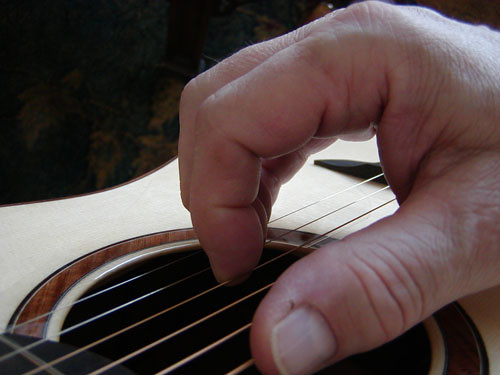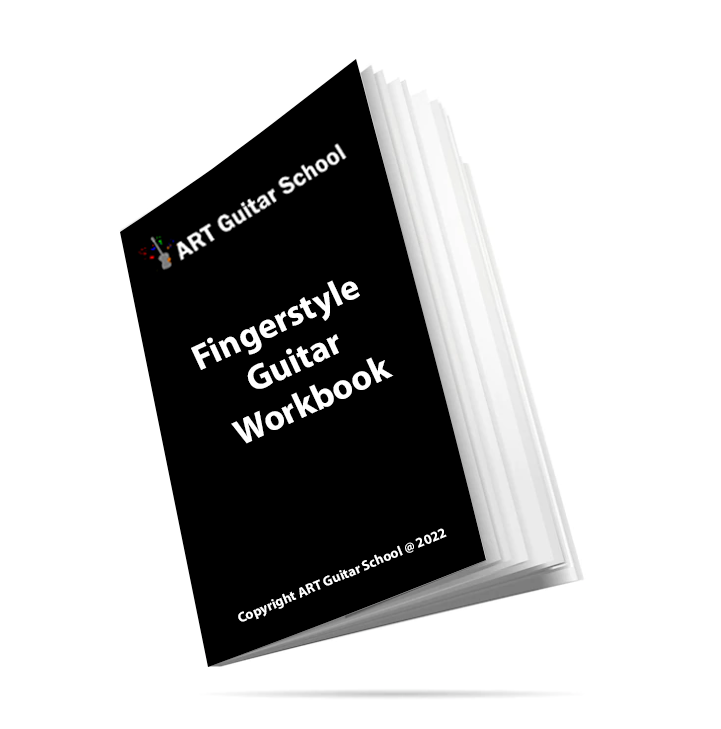One of the most common questions that arise when discussing fingerstyle is if you should use nails or flesh when playing.
Nails require you to either grow out your fingernail or apply acrylics whereas flesh doesn’t require any additional maintenance except for cutting the nails.
You may be asking, what are the main differences and advantages/disadvantages between the two?
Nails
Right off the bat, nails are going to provide a brighter tone due to the material that is striking through the string. With proper shaping and filing technique the nails could provide a warmer tone. This requires several adjustments with the filing of the nail in order for the nail to come out just right for your specific right hand technique. There are many different angles & approaches but all have the same principle.
This picture demonstrates a good nail length and shaping to start with:
Flesh
This route is the most common to start with, as it doesn’t require any additional work in order to play fingerpicking guitar. If we forget the nails and disregard any artificial product we use our flesh to fingerpick. The flesh provides a much warmer tone and less volume as well as dynamic range since it’s not likely to project as well as nails.

Here is a video on nail shaping I recommend:
Deciding on your nails or flesh is based on your personal taste and the sound that you’re trying to achieve. If you were a fingerstyle player or classical guitar player it is recommended that you at least try the nails and see if they’re a good fit for you. If you have brittle nails, there are hardening products and vitamins that can help to be able to strengthen them.
Learn more about technique through our FREE Fingerstyle Workbook!
FOLLOW US ON
Get our FREE Fingerstyle Workbook!
RELATED BLOG POSTS
Fingerstyle Guitar Arrangements: Create Your Own Songs
Creating your own fingerstyle guitar arrangements is an exciting way to express yourself. This post provides guidance on how to develop your own fingerstyle arrangements by starting with simple chords and melodies.
Start with a Simple Chord Progression Choose a simple chord progression, and experiment with playing the bass notes with your thumb while picking the melody with your fingers. As you become comfortable, you can add more complexity to the arrangement.
Add Melodies and Embellishments Once you’ve mastered basic fingerpicking patterns, start incorporating melodies into the arrangement. Add embellishments like hammer-ons, pull-offs, and slides to make the arrangement uniquely yours.
Fingerstyle Guitar Jam Tracks: Practice with Real-World Application
Practicing fingerstyle guitar can sometimes feel like a solitary activity, but playing along with jam tracks can take your skills to the next level. In this post, we explore how using fingerstyle guitar jam tracks can help you apply techniques in a musical context.
Why Use Jam Tracks? Jam tracks simulate the experience of playing with a band or other musicians, giving you a sense of rhythm and timing. This helps you stay in sync, improves your timing, and helps develop the groove of your playing.
Where to Find Jam Tracks There are many websites that offer jam tracks specifically designed for fingerstyle guitar, which include a variety of tempos and genres to fit your skill level. These tracks can be used to practice specific techniques, including basic fingerpicking and advanced rhythmic patterns.
Specialized Fingerstyle Techniques
Fingerstyle guitar is versatile, and mastering specialized techniques can help you stand out. In this post, we dive into specific techniques like Travis picking, thumb independence, and using fingerstyle for vocal accompaniment.
Travis Picking Travis picking is one of the most iconic fingerstyle techniques, where your thumb alternates between the bass strings, while your fingers play the melody on higher strings. It’s the foundation of many classic songs in folk, country, and bluegrass music.
Thumb Independence Building thumb independence is key to mastering fingerstyle. It allows you to maintain a consistent bass rhythm with your thumb while playing more complex melodies and harmonies with your fingers.
Accompanying Vocals with Fingerstyle Fingerstyle is ideal for accompanying your voice while playing guitar. Using basic fingerpicking patterns, you can support your vocals with rich bass lines and melodic accompaniments that fill out the song.





0 Comments